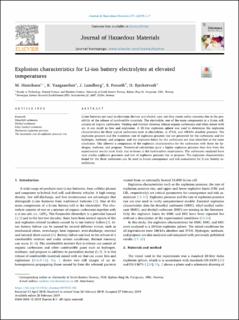| dc.contributor.author | Henriksen, Mathias | |
| dc.contributor.author | Vågsæther, Knut | |
| dc.contributor.author | Lundberg, Joachim | |
| dc.contributor.author | Forseth, Sissel | |
| dc.contributor.author | Bjerketvedt, Dag | |
| dc.date.accessioned | 2020-03-26T07:10:56Z | |
| dc.date.available | 2020-03-26T07:10:56Z | |
| dc.date.created | 2019-05-16T14:59:36Z | |
| dc.date.issued | 2019 | |
| dc.identifier.citation | Journal of Hazardous Materials. 2019, 371 1-7. | en_US |
| dc.identifier.issn | 0304-3894 | |
| dc.identifier.uri | https://hdl.handle.net/11250/2648711 | |
| dc.description.abstract | Li-ion batteries are used in electronic devices and electric cars, yet they create safety concerns due to the possibility of the release of combustible materials. The electrolyte, one of the main components in a Li-ion cell, consists of organic carbonates. Venting and thermal runaway release organic carbonates and when mixed with air, it can result in fires and explosions. A 20-liter explosion sphere was used to determine the explosion characteristics for three typical carbonates used in electrolytes, at 373 K, and 100 kPa absolute pressure. The explosion pressure and the maximum rate of explosion pressure rise are presented for the carbonates and for hydrogen, methane, and propane, and the explosive limits for the carbonates are also identified at the same conditions. This allowed a comparison of the explosion characteristics for the carbonates with those for hydrogen, methane, and propane. Theoretical calculations gave a higher explosion pressure than that from the experimental results most likely due to losses in the hydrocarbon experiments. The carbonates analyzed have very similar explosion pressures and rate of explosion pressure rise as propane. The explosion characteristics found for the three carbonates can be used in future consequence and risk assessments for Li-ion battery installations. | en_US |
| dc.language.iso | eng | en_US |
| dc.rights | Attribution-NonCommercial-NoDerivatives 4.0 Internasjonal | * |
| dc.rights.uri | http://creativecommons.org/licenses/by-nc-nd/4.0/deed.no | * |
| dc.title | Explosion characteristics for Li-ion battery electrolytes at elevated temperatures | en_US |
| dc.type | Peer reviewed | en_US |
| dc.type | Journal article | en_US |
| dc.description.version | publishedVersion | en_US |
| dc.source.pagenumber | 1-7 | en_US |
| dc.source.volume | 371 | en_US |
| dc.source.journal | Journal of Hazardous Materials | en_US |
| dc.identifier.doi | 10.1016/j.jhazmat.2019.02.108 | |
| dc.identifier.cristin | 1698398 | |
| dc.relation.project | Norges forskningsråd: 257653 | en_US |
| cristin.ispublished | true | |
| cristin.fulltext | original | |
| cristin.qualitycode | 2 | |

